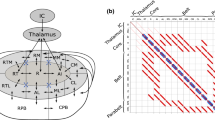Summary
Electric potential maps and magnetic field maps have been used to study brain electrical activity. During the temporal course of an evoked cortical response, the electrical activity of specific neuronal subpopulations change in a sequential manner giving rise to measurable electrical potentials and magnetic fields. For these potentials and fields, both the amplitude and rate of amplitude change have characteristic, time-dependent waveforms. Presently, amplitude waveforms from multiple locations are used to generate magnetic field and electric potential maps which have been found to be useful in understanding the activity of the neurons which give rise to these maps (Romani 1990). This paper introduces a data transformation technique which results in a derived map that we have termed a "finite difference field map" (FDFM). This mapping technique provides information associated with the rate at which the amplitude of the neuronal electric activity changes. In this paper, some advantages of FDFM analysis are illustrated by application of this technique to the study of the auditory evoked cortical field (AECF) N1m waveform. Using data obtained from normal subjects it will be demonstrated that application of the FDFM technique allows the localization of the primary N1m source at an earlier latency than is possible using the conventional waveform data. The source location determined at an early latency by FDFM analysis was identical to that obtained at later latency from the conventional field data. These data suggest that the primary N1m source is stationary. In addition, analysis of the time sequence of FDFM field maps contains evidence of a second spatially separate source which is co-active with primary N1m source.
Similar content being viewed by others
References
Barth, D.S., Sutherling, W., Broffman, J. and Beatty, J. Magnetic localization of a dipolar current source implanted in a sphere and a human cranium. Electroenceph. Clin. Neurophysiol., 1986, 63: 260–273.
Elberling, E., Bak, C., Kofoed, B., Lebech, J. and Soermark, K. Auditory magnetic fields. Scan. Audiol., 1982, 11: 61–65.
Hari, R. The neuromagnetic method in the study of the human auditory cortex. In: F. Grandori, M. Hoke and G.L. Roman (Eds.), Auditory Evoked Magnetic Fields and Electric Potentials. Adv. Audiology, Basel, Karger, 1990, 6: 222–282.
Hoke, M., Feldman, H., Pantev, C., Lutkenhoner, B. and Lehnertz, K. Objective evidence of tinnitus in auditory evoked magnetic fields. Hearing Res., 1989, 37: 281–286.
Jacobson, G.P., Ahmad, B.K., Moran, J., Newman, C.W., Tepley, N. and Wharton, J. Auditory evoked cortical magnetic field (M100–M200) measurements in tinnitus and normal groups. Hearing Research 1991, 51: 44–52.
Kaukoranta, E., Hamalainen, M., Sarvas, J. and Hari, R. Mixed sensory nerve stimulations activate different cytoarchitectonic areas at the human primary somatosensory cortex SI. Neuromagnetic recordings and statistical considerations. Exp. Brain Res., 1986, 63: 60–66.
Lypchuk, T. BTI Report: Dipole fit algorithms for MEG analysis. Biomagnetic Technologies, 1990: 10–12.
Nunez, P. The brain's magnetic field: Some effects of multiple sources on localization methods. Electroenceph. Clin. Neurophysiol., 1986, 63: 75–82.
Oldfield, R.C. The assessment and analysis of handedness: the Edinburgh inventory. Neuropsychol, 1971, 9: 97–112.
Pantev, C., Lutkenhoner, B., Hoke, M. and Lehnertz, K. Comparison between simultaneously recorded auditory-evoked magnetic fields and potentials elicited by ipsilateral, contralateral, and binaural tone burst stimulation. Audiology, 1986, 25: 54–61.
Peronnet, F., Giard, M-H., Bertrand, O. and Pernier J. The temporal component of the auditory evoked potential: A reinterpretation. Electroenceph. Clin Neurophysiol., 1984, 59: 67–71.
Rogers, R.L., Papanicolaou, A.C., Baumann, S.B., Saydjari, C. and Eisenberg, H.M. Neuromagnetic evidence of a dynamic excitation pattern generating the N100 auditory response. Electroenceph. Clin. Neurophysiol., 1990, 77: 237–240.
Romani, G.L. and Pizzella, V. Localization of brain activity with magnetoencephalography. Raven Press, New York, 1990: 67–77.
Scherg, M. and von Cramon, D. Two bilateral sources of the late AEF as identified by a spatio-temporal dipole model. Electroenceph. clin Neurophysiol., 1985, 62: 32–144.
Scherg, M. and von Cramon, D. Evoked dipole source potentials of the human auditory cortex. Electronenceph. Clin. Neurophysiol., 1986, 65: 344–360.
Wolpaw, J.R. and Penry, J.K. A temporal component of the auditory evoked response. Electroenceph. Clin. Neurophysiol., 1975, 39: 609–620.
Wood, C.C. and Wolpaw, J.R. Scalp distribution of human auditory evoked potentials. II. Evidence for overlapping sources and involvement of auditory cortex. Electroenceph. Clin. Neurophysiol. 1982, 54: 25–38.
Author information
Authors and Affiliations
Rights and permissions
About this article
Cite this article
Moran, J.E., Tepley, N., Jacobson, G.P. et al. Evidence for multiple generators in evoked responses using finite difference field mapping: Auditory evoked fields. Brain Topogr 5, 229–240 (1993). https://doi.org/10.1007/BF01128990
Accepted:
Issue Date:
DOI: https://doi.org/10.1007/BF01128990




